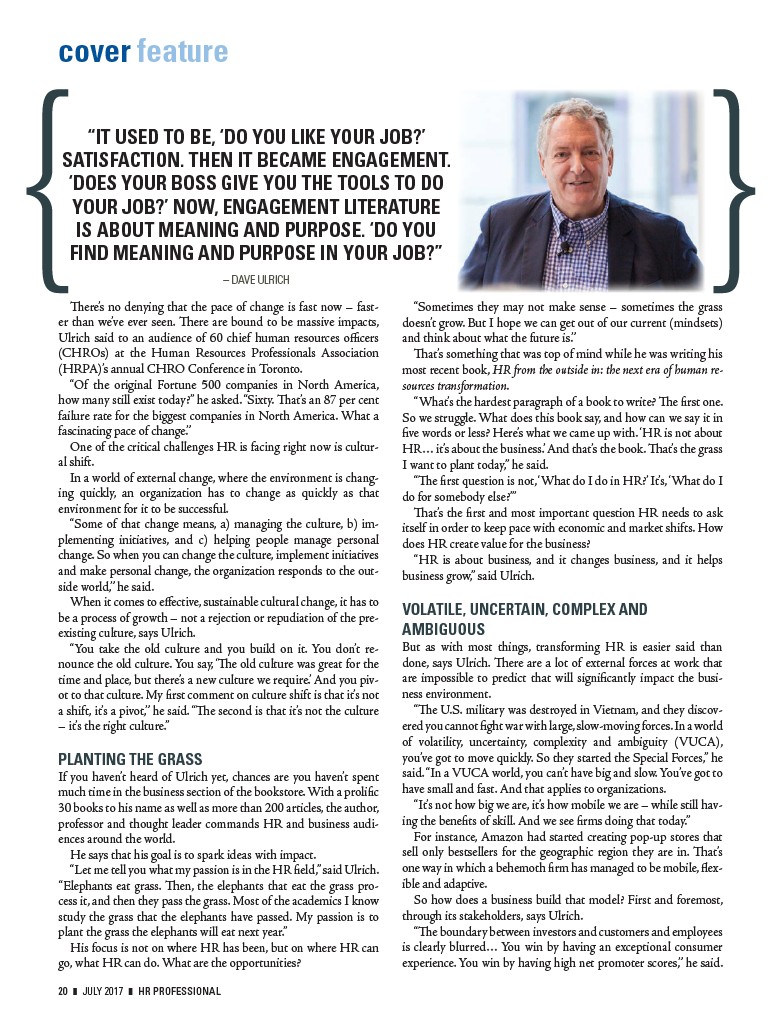
There’s no denying that the pace of change is fast now – faster
than we’ve ever seen. There are bound to be massive impacts,
Ulrich said to an audience of 60 chief human resources officers
(CHROs) at the Human Resources Professionals Association
(HRPA)’s annual CHRO Conference in Toronto.
“Of the original Fortune 500 companies in North America,
how many still exist today?” he asked. “Sixty. That’s an 87 per cent
failure rate for the biggest companies in North America. What a
fascinating pace of change.”
One of the critical challenges HR is facing right now is cultural
shift.
In a world of external change, where the environment is changing
quickly, an organization has to change as quickly as that
environment for it to be successful.
“Some of that change means, a) managing the culture, b) implementing
initiatives, and c) helping people manage personal
change. So when you can change the culture, implement initiatives
and make personal change, the organization responds to the outside
world,” he said.
When it comes to effective, sustainable cultural change, it has to
be a process of growth – not a rejection or repudiation of the preexisting
culture, says Ulrich.
“You take the old culture and you build on it. You don’t renounce
the old culture. You say, ‘The old culture was great for the
time and place, but there’s a new culture we require.’ And you pivot
to that culture. My first comment on culture shift is that it’s not
a shift, it’s a pivot,” he said. “The second is that it’s not the culture
– it’s the right culture.”
PLANTING THE GRASS
If you haven’t heard of Ulrich yet, chances are you haven’t spent
much time in the business section of the bookstore. With a prolific
30 books to his name as well as more than 200 articles, the author,
professor and thought leader commands HR and business audiences
around the world.
He says that his goal is to spark ideas with impact.
“Let me tell you what my passion is in the HR field,” said Ulrich.
“Elephants eat grass. Then, the elephants that eat the grass process
it, and then they pass the grass. Most of the academics I know
study the grass that the elephants have passed. My passion is to
plant the grass the elephants will eat next year.”
His focus is not on where HR has been, but on where HR can
go, what HR can do. What are the opportunities?
“Sometimes they may not make sense – sometimes the grass
doesn’t grow. But I hope we can get out of our current (mindsets)
and think about what the future is.”
That’s something that was top of mind while he was writing his
most recent book, HR from the outside in: the next era of human resources
transformation.
“What’s the hardest paragraph of a book to write? The first one.
So we struggle. What does this book say, and how can we say it in
five words or less? Here’s what we came up with. ‘HR is not about
HR… it’s about the business.’ And that’s the book. That’s the grass
I want to plant today,” he said.
“The first question is not, ‘What do I do in HR?’ It’s, ‘What do I
do for somebody else?’”
That’s the first and most important question HR needs to ask
itself in order to keep pace with economic and market shifts. How
does HR create value for the business?
“HR is about business, and it changes business, and it helps
business grow,” said Ulrich.
VOLATILE, UNCERTAIN, COMPLEX AND
AMBIGUOUS
But as with most things, transforming HR is easier said than
done, says Ulrich. There are a lot of external forces at work that
are impossible to predict that will significantly impact the business
environment.
“The U.S. military was destroyed in Vietnam, and they discovered
you cannot fight war with large, slow-moving forces. In a world
of volatility, uncertainty, complexity and ambiguity (VUCA),
you’ve got to move quickly. So they started the Special Forces,” he
said. “In a VUCA world, you can’t have big and slow. You’ve got to
have small and fast. And that applies to organizations.
“It’s not how big we are, it’s how mobile we are – while still having
the benefits of skill. And we see firms doing that today.”
For instance, Amazon had started creating pop-up stores that
sell only bestsellers for the geographic region they are in. That’s
one way in which a behemoth firm has managed to be mobile, flexible
and adaptive.
So how does a business build that model? First and foremost,
through its stakeholders, says Ulrich.
“The boundary between investors and customers and employees
is clearly blurred… You win by having an exceptional consumer
experience. You win by having high net promoter scores,” he said.
cover feature
“IT USED TO BE, ‘DO YOU LIKE YOUR JOB?’
SATISFACTION. THEN IT BECAME ENGAGEMENT.
‘DOES YOUR BOSS GIVE YOU THE TOOLS TO DO
YOUR JOB?’ NOW, ENGAGEMENT LITERATURE
IS ABOUT MEANING AND PURPOSE. ‘DO YOU
FIND MEANING AND PURPOSE IN YOUR JOB?”
– DAVE ULRICH
20 ❚ JULY 2017 ❚ HR PROFESSIONAL